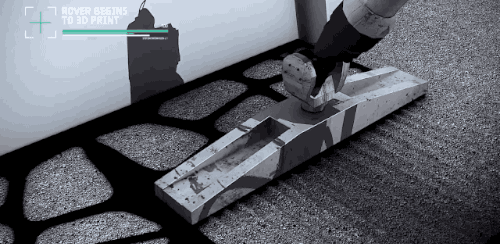 3D printing has, over the years, become connected to space travel in countless ways; in fact, entities like NASA were using the technology before most of us even had an inkling of it. My favorite subject to write about though, hands down, is using 3D printing to colonize space. I’m not alone in my fascination either, as this is a big topic lately–mainly for Mars, as we’ve watched it being offered up as the motif for contests, ideas of downright whimsy, as well as architectural concepts that may very well also become models for colonization reality on the Moon, and who knows where else, eventually.
3D printing has, over the years, become connected to space travel in countless ways; in fact, entities like NASA were using the technology before most of us even had an inkling of it. My favorite subject to write about though, hands down, is using 3D printing to colonize space. I’m not alone in my fascination either, as this is a big topic lately–mainly for Mars, as we’ve watched it being offered up as the motif for contests, ideas of downright whimsy, as well as architectural concepts that may very well also become models for colonization reality on the Moon, and who knows where else, eventually.
Last we heard from the ESA, they were busy getting quite serious about the subject of colonizing the Moon, and had enlisted the services of architectural firm Foster + Partners to help propel their idea and give a glimpse into what this might look like, with robots digging moon dirt—or regolith—to use as construction material. This was very exciting when we looked into it previously, and I certainly couldn’t wait to hear the rest of the story, something akin to a very long and drawn out episode of our future Homes & Gardens on the Moon.
Now, the ESA has brought in more resources to expound on moon colonization via teamwork between robots and humans. While it may seem that moon talk is relegated to lower levels these days as we’re all hyped up about getting to Mars–post mass world viewings of The Martian–this is a very real plan, and considering how much time is being spent talking about colonization and building there, it’s probably safe to consider it might happen fairly soon.
 This was all outlined recently at the European Space Research and Technology Center in Noordwijk, Netherlands, during a symposium titled ‘Moon 2020-2030 – A New Era of Coordinated Human and Robotic Exploration.’ The new Director General of the ESA, Jan Woerner, led in explaining the vision they foresee for colonizing the Moon, we well as using it as something like a staging platform for other missions.
This was all outlined recently at the European Space Research and Technology Center in Noordwijk, Netherlands, during a symposium titled ‘Moon 2020-2030 – A New Era of Coordinated Human and Robotic Exploration.’ The new Director General of the ESA, Jan Woerner, led in explaining the vision they foresee for colonizing the Moon, we well as using it as something like a staging platform for other missions.
“The future of space travel needs a new vision. Right now we have the Space Station as a common international project, but it won’t last forever. If I say Moon Village, it does not mean single houses, a church, a town hall and so on… My idea only deals with the core of the concept of a village: people working and living together in the same place,” Woerner said during the symposium. “And this place would be on the Moon. In the Moon Village we would like to combine the capabilities of different spacefaring nations, with the help of robots and astronauts. The participants can work in different fields, perhaps they will conduct pure science and perhaps there will even be business ventures like mining or tourism.”
The group also spent time examining the International Space Exploration Coordinated Group‘s (ISECG) Global Exploration Roadmap, an agenda for space exploration that was drafted by the group’s 14 members – which includes NASA, the ESA, Roscosmos, and other federal agencies. According to the symposium information, those in charge see the challenges being met in a series of progressions, as follows:
- Automated missions to human-robotic cooperation strategies.
- National and bilateral to multilateral cooperation.
- Missions to architectures.
- Government-driven to common goals of public and private sector.
- PI-driven to open science opportunities.
“This vision envisages access for robots and humans to previously unexplored regions,” states information from the Symposium outline.
“This will be a shared journey. New and bold ambitions for lunar exploration call for a new era of coordinated human and robotic missions. Humans and robots are set to explore the Moon together. The ISECG Global Exploration Roadmap underlines the strategic significance of the Moon in a global space exploration endeavour, calling for a shared international vision on how to best accomplish common lunar exploration goals. The International Space Station programme has demonstrated the importance of a robust international partnership for ISS development, assembly, operations and effective utilisation. Now is the time to build on this partnership and open it to new partners to continue the journey beyond low Earth orbit.”
While once upon a time, just being able to have a base on the Moon would have been enough in itself, now we indeed seem to see it too as a definite way to help in getting us elsewhere, with lunar lodgings serving as a stepping stone—although a very busy one, from the sound of it. And that’s not just for convenience sake, as having a base on the Moon could save many billions of dollars in terms of other space missions, like the one planned for Mars. Researchers also see a great deal of data being gleaned from the Moon as well, in terms of space research and planning for missions. Also very interesting is the territorial aspect of our establishing a space station on the Moon. Might it become ‘ours?”
 There are so many exciting aspects to consider about establishing a way to live on the Moon, and we haven’t even again yet begun to consider the amount of revenue that could be brought in due to tourism, a la Richard Branson, as civilians pay big bucks just to get a ‘fly by.’ What if they could actually spend the weekend?
There are so many exciting aspects to consider about establishing a way to live on the Moon, and we haven’t even again yet begun to consider the amount of revenue that could be brought in due to tourism, a la Richard Branson, as civilians pay big bucks just to get a ‘fly by.’ What if they could actually spend the weekend?
As it stands, were this to happen, researchers see its locale as being the southern polar region, which is optimal as it is almost always twilight there. There will be a mission there by 2020, as the ESA and Roscosmos send a robotic probe to take samples of ice.
Questions abound, as we wait to see what will really happen, but 3D printing is seems will most certainly play a role in construction, as will robotics. And none of that is farfetched, as we are already seeing 3D printing playing a role in large construction as well as that of use with robotic arms. One can only imagine the racket all the space construction might make as you try to sleep in your little above ground regolith moon bubble, but that would be a small price to pay to visit a lunar base. For now, we wait further on the ESA, an entity which certainly seems persistent, yet held back by a true way to pull off their plan–for the moment.
[Source: Universe Today]Subscribe to Our Email Newsletter
Stay up-to-date on all the latest news from the 3D printing industry and receive information and offers from third party vendors.
You May Also Like
3D Printing Unpeeled: New Arkema Material for HP, Saddle and Macro MEMS
A new Arkema material for MJF is said to reduce costs per part by up to 25% and have an 85% reusability ratio. HP 3D HR PA 12 S has been...
3D Printing News Briefs, January 20, 2024: FDM, LPBF, Underwater 3D Printer, Racing, & More
We’re starting off with a process certification in today’s 3D Printing News Briefs, and then moving on to research about solute trapping, laser powder bed fusion, and then moving on...
3D Printing Webinar and Event Roundup: December 3, 2023
We’ve got plenty of events and webinars coming up for you this week! Quickparts is having a Manufacturing Roadshow, America Makes is holding a Member Town Hall, Stratafest makes two...
Formnext 2023 Day Three: Slam Dunk
I’m high—high on trade show. I’ve met numerous new faces and reconnected with old friends, creating an absolutely wonderful atmosphere. The excitement is palpable over several emerging developments. The high...































